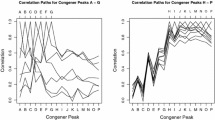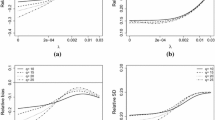Appendix 1. Calculations for grouped censoring
EM algorithm
Let x1, x2, ...., xnbe a censored sample from a location-scale distribution where all {xi : d1 < xi < d2are censored; d1 and d2 are fixed detection limits. Assume that there are no non-detected (censored) values and r = n − no uncensored values. Let us define δi as follows
$$ {\delta}_i=\left\{\begin{array}{l}0\kern0.48em :{d}_1<{x}_i{d}_2\\ {}1\kern0.6em : otherwise,\end{array}\right. $$
in this case, the likelihood function will take the form
$$ L\left(\mu, \sigma \right)=\prod \limits_{i=1}^n\left(\frac{1}{0}f\left({z}_i\right)\right){\delta}_i{\left({\int}_{\xi_1}^{\xi_2}f(z) dz\right)}^{1-{\delta}_i} $$
where f(t) and F(t) are the probability density function and the cumulative distribution function for the standard location-scale parameter (free of μ and σ),\( {\xi}_j=\frac{d_j-\mu }{\sigma },j=1,2\; and\;{z}_i=\frac{x_i-\mu }{\sigma } \). Hence, the log-likelihood function is given by
$$ {\displaystyle \begin{array}{l}\ell \left(\mu, \sigma \right)=-r\;\log \sigma +\sum \limits_{i=1}^n\left[{\delta}_i\;\log\;f\left({z}_i\right)+\left(1-{\delta}_i\right)\;\log {\int}_{\xi_1}^{\xi_2}f(z) dz\right]\\ {}\kern1.92em =-r\;\log \sigma +\sum \limits_{i=1}^n{\delta}_i\;\log\;f\left({z}_i\right)+{n}_o\;\log \left(F\left({\xi}_2\right)-F\left({\xi}_1\right)\right)\end{array}} $$
Let \( C\left({\xi}_1,{\xi}_2\right)=\log {\int}_{\xi_1}^{\xi_2}f(z) dz; \) the censored part in the log-likelihood Eq. (4). Then we have the following
$$ {\displaystyle \begin{array}{l}\frac{\partial }{\partial \mu }C\left({\xi}_1,{\xi}_2\right)=\frac{1}{\int_{\xi_1}^{\xi_2}f(z) dz}{\int}_{\xi_1}^{\xi_2}\frac{\partial f}{\partial \mu } dz\\ {}\kern5.5em =\frac{1}{\int_{\xi_1}^{\xi_2}f(z) dz}{\int}_{\xi_1}^{\xi_2}\frac{\partial \log f(z)}{\partial \mu }f(z) dz\\ {}\begin{array}{l}\kern5.5em =E\left[\frac{\partial \log f(z)}{\partial \mu}\left|{\xi}_1<z<\right.{\xi}_2\right]\\ {}\kern5.5em =-\frac{1}{\sigma }E\left[\frac{\partial \log f(z)}{\partial z}\left|{\xi}_1<z<\right.{\xi}_2\right]\\ {}\kern5.5em =-\frac{1}{\sigma}\frac{f\left({\xi}_2\right)-f\left({\xi}_1\right)}{F\left({\xi}_2\right)-F\left({\xi}_1\right)}\end{array}\end{array}} $$
(25)
$$ {\displaystyle \begin{array}{l}\frac{\partial^2}{\partial {\mu}^2}C\left({\xi}_1,{\xi}_2\right)=\frac{\partial }{\partial \mu}\frac{1}{\int \begin{array}{c}{\xi}_2\\ {}{\xi}_1\end{array}f(z) dz}\int \begin{array}{c}{\xi}_2\\ {}{\xi}_1\end{array}\frac{\partial f(z)}{\partial \mu } dz\\ {}\kern6em =\frac{1}{\int \begin{array}{c}{\xi}_2\\ {}{\xi}_1\end{array}f(z) dz}\int \begin{array}{c}{\xi}_2\\ {}{\xi}_1\end{array}\frac{\partial }{\partial \mu}\left[\frac{\partial \log f(z)}{\partial \mu }f(z)\right] dz-{\left(\frac{1}{\int \begin{array}{c}{\xi}_2\\ {}{\xi}_1\end{array}f(z) dz}\int \begin{array}{c}{\xi}_2\\ {}{\xi}_1\end{array}\frac{\partial f(z)}{\partial \mu } dz\right)}^2\\ {}\begin{array}{l}\kern6em =E\left[\left.\frac{\partial^2\log f(z)}{\partial {\mu}^2}\right|{\xi}_1<z<{\xi}_2\right]+E\left[\left.{\left(\frac{\partial \log f(z)}{\partial \mu}\right)}^2\right|{\xi}_1<z<{\xi}_2\right]-{\left(E\left[\left.\frac{\partial \log f(z)}{\partial \mu}\right|{\xi}_1<z<{\xi}_2\right]\right)}^2\\ {}\kern6em =\frac{1}{\sigma^2}\left(E\left[\left.\frac{\partial^2\log f(z)}{\partial {z}^2}\right|{\xi}_1<z<{\xi}_2\right]+E\left[\left.\left(\frac{\partial \log f(z)}{\partial z}\right)2\right|{\xi}_1<z<{\xi}_2\right]-{\left(E\left[\left.\frac{\partial \log f(z)}{\partial z}\right|{\xi}_1<z<{\xi}_2\right]\right)}^2\right)\\ {}\kern6em =\frac{1}{\sigma^2}\left(\frac{\frac{\partial f\left({\xi}_2\right)}{\partial {\xi}_2}-\frac{\partial f\left({\xi}_1\right)}{\partial {\xi}_1}}{F\left({\xi}_2\right)-F\left({\xi}_1\right)}-{\left(\frac{f\left({\xi}_2\right)-f\left({\xi}_1\right)}{F\left({\xi}_2\right)-F\left({\xi}_1\right)}\right)}^2\right)\end{array}\end{array}} $$
(26)
$$ {\displaystyle \begin{array}{l}\frac{\partial }{\partial \sigma }C\left({\xi}_1,{\xi}_2\right)=\frac{1}{\int \begin{array}{c}{\xi}_2\\ {}{\xi}_1\end{array}f(z) dz}\int \begin{array}{c}{d}_2\\ {}{d}_1\end{array}\frac{\partial }{\partial \sigma}\left[\frac{1}{\sigma }f\left(\frac{x-\mu }{\sigma}\right)\right] dx\\ {}\kern5.5em =\frac{1}{\sigma }+\frac{1}{\int \begin{array}{c}{\xi}_2\\ {}{\xi}_1\end{array}f(z) dz}\int \begin{array}{c}{\xi}_2\\ {}{\xi}_1\end{array}\frac{\partial \log f(z)}{\partial \sigma }f(z) dz\\ {}\begin{array}{l}\kern5.5em =-\frac{1}{\sigma }+E\left[\left.\frac{\partial \log f(z)}{\partial \sigma}\right|{\xi}_1<z<{\xi}_2\right]\\ {}\kern5.5em =-\frac{1}{\sigma}\left(1+E\left[\left.\frac{z\partial \log f(z)}{\partial z}\right|{\xi}_1<z<{\xi}_2\right]\right)\\ {}\kern5.5em =-\frac{1}{\sigma}\frac{\xi_2f\left({\xi}_2\right)-{\xi}_1f\left({\xi}_1\right)}{F\left({\xi}_2\right)-F\left({\xi}_1\right)}\end{array}\end{array}} $$
(27)
$$ {\displaystyle \begin{array}{l}\frac{\partial^2}{\partial {\sigma}^2}C\left({\xi}_1,{\xi}_2\right)=\frac{1}{\sigma^2}+\frac{\partial }{\partial \sigma}\frac{1}{\int \begin{array}{c}{\xi}_2\\ {}{\xi}_1\end{array}f(z) dz}\int \begin{array}{c}{d}^2\\ {}{d}^1\end{array}\frac{1}{\sigma}\frac{\partial f\left(\frac{x-\mu }{\sigma}\right)}{\partial \sigma } dx\\ {}\kern6em =\frac{1}{\sigma^2}+\frac{1}{\int \begin{array}{c}{\xi}_2\\ {}{\xi}_1\end{array}f(z) dz}\int \begin{array}{c}{d}_2\\ {}{d}_1\end{array}\frac{\partial }{\partial \sigma}\left[\frac{1}{\sigma}\frac{\partial \log f\left(\frac{x-\mu }{\sigma}\right)}{\partial \sigma }f\left(\frac{x-\mu }{\sigma}\right)\right] dx-{\left(\frac{1}{\int \begin{array}{c}{\xi}_2\\ {}{\xi}_1\end{array}f(z) dz}\int \begin{array}{c}{\xi}_2\\ {}{\xi}_1\end{array}\frac{\partial f(z)}{\partial \sigma } dz\right)}^2\\ {}\begin{array}{l}\kern6em =\frac{1}{\sigma^2}-\frac{1}{\sigma }E\left[\left.\frac{\partial \log f(z)}{\partial \sigma}\right|{\xi}_1<z<{\xi}_2\right]+E\left[\left.\frac{\partial \log f(z)}{\partial {\sigma}^2}\right|{\xi}_1<z<{\xi}_2\right]\\ {}\kern6em +E\left[\left.{\left(\frac{\partial \log f(z)}{\partial \sigma}\right)}^2\right|{\xi}_1<z<{\xi}_2\right]-{\left(E\left[\left.\frac{\partial \log f(z)}{\partial \sigma}\right|{\xi}_1<z<{\xi}_2\right]\right)}^2\\ {}\begin{array}{l}\kern6em =\frac{2}{\sigma^2}\left(1+E\left[\left.\frac{z\partial \log f(z)}{\partial z}\right|{\xi}_1<z{\xi}_2\right]\right)\\ {}\kern6em +\frac{1}{\sigma^2}\left(E\left[\left.{z}^2\frac{\partial^2\log f(z)}{\partial {z}^2}\right|{\xi}_1<z<{\xi}_2\right]+E\left[\left.{\left(z\frac{\partial \log f(z)}{\partial z}\right)}^2\right|{\xi}_1<z<{\xi}_2\right]-{\left(E\left[\left.z\frac{\partial \log f(z)}{\partial z}\right|{\xi}_1<z<{\xi}_2\right]\right)}^2\right)\\ {}\kern6em =\frac{2}{\sigma^2}\frac{\xi_2f\left({\xi}_2\right)-{\xi}_1f\left({\xi}_1\right)}{F\left({\xi}_2\right)-F\left({\xi}_1\right)}+\frac{1}{\sigma^2}\left(\frac{\xi \begin{array}{c}2\\ {}2\end{array}\frac{\partial f\left({\xi}_2\right)}{\partial {\xi}_2}-\xi \begin{array}{c}2\\ {}1\end{array}\frac{\partial f\left({\xi}_1\right)}{\partial {\xi}_1}}{F\left({\xi}_2\right)-F\left({\xi}_1\right)}-{\left(\frac{\xi_2f\left({\xi}_2\right)-{\xi}_1f\left({\xi}_1\right)}{F\left({\xi}_2\right)-F\left({\xi}_1\right)}\right)}^2\right)\end{array}\end{array}\end{array}} $$
(28)
$$ {\displaystyle \begin{array}{l}\frac{\partial^2}{\partial \mu \partial \sigma }C\left({\xi}_1,{\xi}_2\right)=\frac{\partial }{\partial \mu}\frac{1}{\int \begin{array}{c}{\xi}_2\\ {}{\xi}_1\end{array}f(z) dz}\int \begin{array}{c}{\xi}_2\\ {}{\xi}_1\end{array}\frac{\partial f(z)}{\partial \sigma } dz\\ {}\begin{array}{l}\kern6.75em =\frac{1}{\int \begin{array}{c}{\xi}_2\\ {}{\xi}_1\end{array}f(z) dz}\int \begin{array}{c}{\xi}_2\\ {}{\xi}_1\end{array}\frac{\partial }{\partial \mu}\left[\frac{\partial \log f(z)}{\partial \sigma }f(z)\right] dz-\frac{1}{{\left(\int \begin{array}{c}{\xi}_2\\ {}{\xi}_1\end{array}f(z) dz\right)}^2}\int \begin{array}{c}{\xi}_2\\ {}{\xi}_1\end{array}\frac{\partial f(z)}{\partial \mu } dz\int \begin{array}{c}{\xi}_2\\ {}{\xi}_1\end{array}\frac{\partial f(z)}{\partial \sigma } dz\\ {}\kern6.75em =E\left[\left.\frac{\partial \log f(z)}{\partial \sigma}\frac{\partial \log f(z)}{\partial \mu}\right|{\xi}_1<z<{\xi}_2\right]+E\left[\left.\frac{\partial^2\log f(z)}{\partial \sigma \partial \mu}\right|{\xi}_1<z<{\xi}_2\right]\\ {}\kern6.75em -E\left[\left.\frac{\partial \log f(z)}{\partial \sigma}\right|{\xi}_1<z<{\xi}_2\right]E\left[\left.\frac{\partial \log f(z)}{\partial \mu}\right|{\xi}_1<z<{\xi}_2\right]\end{array}\\ {}\begin{array}{l}\kern6.75em =\frac{1}{\sigma^2}\left(E\left[\left.z{\left(\frac{\partial \log f(z)}{\partial z}\right)}^2\right|{\xi}_1<z<{\xi}_2\right]+E\left[\left.z\frac{\partial^2\log f(z)}{\partial {z}^2}\right|{\xi}_1<z<{\xi}_2\right]-E\left[\left.z\frac{\partial \log f(z)}{\partial z}\right|{\xi}_1<z<{\xi}_2\right]E\left[\left.\frac{\partial \log f(z)}{\partial z}\right|{\xi}_1<z<{\xi}_2\right]\right)\\ {}\kern6.75em =\frac{1}{\sigma^2}\left[\frac{f\left({\xi}_2\right)-f\left({\xi}_1\right)}{F\left({\xi}_2\right)-F\left({\xi}_1\right)}+\frac{\left(F\left({\xi}_2\right)-F\left({\xi}_1\right)\right)\left({\xi}_2\frac{\partial f\left({\xi}_2\right)}{\partial {\xi}_2}-{\xi}_1\frac{\partial f\left({\xi}_1\right)}{\partial {\xi}_1}\right)-\left(f\left({\xi}_2\right)-f\left({\xi}_1\right)\right)\left({\xi}_2f\left({\xi}_2\right)-{\xi}_1f\left({\xi}_1\right)\right)}{{\left(F\left({\xi}_2\right)-F\left({\xi}_1\right)\right)}^2}\right]\end{array}\end{array}} $$
(29)
Modified likelihood
The censored term in the log-likelihood equation may be modified using the Taylor series using the quadratic approximation.
We may approximate \( C\left({\xi}_1,{\xi}_2\right)=\log \int {\displaystyle \begin{array}{c}{\xi}_2\\ {}{\xi}_1\end{array}}f(z) dz \) as the following
$$ {\displaystyle \begin{array}{c}C\left({\xi}_1,{\xi}_2\right)\approx C\left({\hat{\xi}}_1,{\hat{\xi}}_2\right)+{C}_{\xi_1}\left({\hat{\xi}}_1,{\hat{\xi}}_2\right)\left({\xi}_1-{\hat{\xi}}_1\right)+{C}_{\xi_2}\left({\hat{\xi}}_1,{\hat{\xi}}_2\right)\left({\xi}_2-{\hat{\xi}}_2\right)\\ {}+\frac{1}{2!}\left[{C}_{\xi_1{\xi}_1}\left({\hat{\xi}}_1,{\hat{\xi}}_2\right){\left({\xi}_1-{\hat{\xi}}_1\right)}^2+2{C}_{\xi_1{\xi}_2}\left({\hat{\xi}}_1,{\hat{\xi}}_2\right)\left({\xi}_1-{\hat{\xi}}_1\right)\left({\xi}_2-{\hat{\xi}}_2\right)+{C}_{\xi_2{\xi}_2}\left({\hat{\xi}}_1,{\hat{\xi}}_2\right){\left({\xi}_2-{\hat{\xi}}_2\right)}^2\right]\end{array}} $$
which can be written as
$$ C\left({\xi}_1,{\xi}_2\right)\approx C+ $$
$$ {\displaystyle \begin{array}{c}C=C\left({\hat{\xi}}_1,{\hat{\xi}}_2\right)-{\hat{\xi}}_1{C}_{\xi_1}\left({\hat{\xi}}_1,{\hat{\xi}}_2\right)-{\hat{\xi}}_2{C}_{\xi_2}\left({\hat{\xi}}_1,{\hat{\xi}}_2\right)+\frac{1}{2}\hat{\xi}\begin{array}{c}2\\ {}1\end{array}{C}_{\xi_1{\xi}_1}\left({\hat{\xi}}_1,{\hat{\xi}}_2\right)+\frac{1}{2}\hat{\xi}\begin{array}{c}2\\ {}2\end{array}{C}_{\xi_2{\xi}_2}\left({\hat{\xi}}_1,{\hat{\xi}}_2\right)+{\hat{\xi}}_1{\hat{\xi}}_2{C}_{\xi_1{\xi}_2}\left({\hat{\xi}}_1,{\hat{\xi}}_2\right)\\ {}{\leftthreetimes}_1={C}_{\xi_1}\left({\hat{\xi}}_1,{\hat{\xi}}_2\right)-{\hat{\xi}}_1{C}_{\xi_1{\xi}_1}\left({\hat{\xi}}_1,{\hat{\xi}}_2\right)-{\hat{\xi}}_2{C}_{\xi_1{\xi}_2}\left({\hat{\xi}}_1,{\hat{\xi}}_2\right)\\ {}\begin{array}{c}{\leftthreetimes}_2={C}_{\xi_2}\left({\hat{\xi}}_1,{\hat{\xi}}_2\right)-{\hat{\xi}}_2{C}_{\xi_2{\xi}_2}\left({\hat{\xi}}_1,{\hat{\xi}}_2\right)-{\hat{\xi}}_1{C}_{\xi_1{\xi}_2}\left({\hat{\xi}}_1,{\hat{\xi}}_2\right)\\ {}{\leftthreetimes}_3=\frac{1}{2}{C}_{\xi_1{\xi}_1}\left({\hat{\xi}}_1,{\hat{\xi}}_2\right)\\ {}\begin{array}{c}{\leftthreetimes}_4=\frac{1}{2}{C}_{\xi_2{\xi}_2}\left({\hat{\xi}}_1,{\hat{\xi}}_2\right)\\ {}{\leftthreetimes}_5={C}_{\xi_1{\xi}_2}\left({\hat{\xi}}_1{\hat{\xi}}_2\right)\end{array}\end{array}\end{array}} $$
where \( {\hat{\xi}}_1 \) and \( {\hat{\xi}}_2 \) may be estimated using the proportion of censored values as \( {\hat{\xi}}_1={F}^{-1}\left(\frac{n_2-{n}_0}{n}\right),{\hat{\xi}}_2={F}^{-1}\left(\frac{n_2}{n}\right),{n}_2=\sum {\displaystyle \begin{array}{c}n\\ {}i=1\end{array}}{\delta}_{2i}, \)
$$ {\delta}_{2i}=\left\{\begin{array}{c}1:{z}_i<{\xi}_2\\ {}0:\mathrm{otherwise}\end{array}\right. $$
and
$$ \int {\displaystyle \begin{array}{c}{\xi}_2\\ {}{\hat{\xi}}_1\end{array}}f(z) dz=\frac{n_o}{n} $$
So we can write the log-likelihood function as
$$ \ell \left(\mu, \sigma \right)=-r\log \sigma +\sum \limits_{i=1}^n{\delta}_i\log f\left({z}_i\right)+{n}_o\left(C+{\leftthreetimes}_1{\xi}_1+{\leftthreetimes}_2{\xi}_2+{\leftthreetimes}_3\xi \begin{array}{c}2\\ {}1\end{array}+{\leftthreetimes}_4\xi \begin{array}{c}2\\ {}2\end{array}+{\leftthreetimes}_5{\xi}_1{\xi}_2\right) $$
(30)
And so the first and the second derivatives with respect to μ and σ are:
$$ \frac{\partial \ell }{\partial \mu }=-\frac{1}{\sigma}\left[\sum \limits_{i=1}^n{\delta}_i\frac{\partial \log f\left({z}_i\right)}{\partial {z}_i}+{n}_o\left(\left({\leftthreetimes}_1+{\leftthreetimes}_2\right)+\left(2{\leftthreetimes}_3+{\leftthreetimes}_5\right){\xi}_1+\left(2{\leftthreetimes}_4+{\leftthreetimes}_5\right){\xi}_2\right)\right] $$
(31)
$$ \frac{\partial \ell }{\partial \sigma }=-\frac{r}{\sigma }-\frac{1}{\sigma}\left[\sum \limits_{i=1}^n{\delta}_i{z}_i\frac{\partial^2\log f\left({z}_i\right)}{\partial {z}_i}+{n}_o\left({\leftthreetimes}_1{\xi}_1+{\leftthreetimes}_2{\xi}_2+2{\leftthreetimes}_3\xi \begin{array}{c}2\\ {}1\end{array}+2{\leftthreetimes}_4\xi \begin{array}{c}2\\ {}2\end{array}+2{\leftthreetimes}_5{\xi}_1{\xi}_2\right)\right] $$
(32)
$$ \frac{\partial^2\ell }{\partial {\mu}^2}=\frac{1}{\sigma^2}\left[\sum \limits_{i=1}^n{\delta}_i\frac{\partial^2\log f\left({z}_i\right)}{\partial z\begin{array}{c}2\\ {}i\end{array}}+2{n}_o\left({\leftthreetimes}_3+{\leftthreetimes}_4+{\leftthreetimes}_5\right)\right] $$
(33)
$$ \frac{\vartheta^2\ell }{\vartheta {\sigma}^2}=\frac{r}{\sigma^2}+\frac{1}{\sigma^2}\left[\sum \limits_{i=1}^n{\delta}_i{z}_i\frac{\partial \log f\left({z}_i\right)}{\partial {z}_i}+\sum \limits_{i=1}^n{\delta}_iz\begin{array}{c}2\\ {}i\end{array}\frac{\partial \log f\left({z}_i\right)}{\partial z\begin{array}{c}2\\ {}i\end{array}}\right]+\frac{2}{\sigma^2}\left[{n}_o\left({\leftthreetimes}_1{\xi}_1+{\leftthreetimes}_2{\xi}_2+3{\leftthreetimes}_3\xi \begin{array}{c}2\\ {}1\end{array}+3{\leftthreetimes}_4\xi \begin{array}{c}2\\ {}2\end{array}+3{\leftthreetimes}_5{\xi}_1{\xi}_2\right)\right] $$
(34)
$$ \frac{\vartheta^2\ell }{\vartheta \sigma \vartheta \mu}=\frac{1}{\sigma^2}\left[\sum \limits_{i=1}^n{\delta}_i\frac{\partial \log f\left({z}_i\right)}{\partial {z}_i}+\sum \limits_{i=1}^n{\delta}_i{z}_i\frac{\partial^2\log f\left({z}_i\right)}{\partial z\begin{array}{c}2\\ {}i\end{array}}\right]+\frac{1}{\sigma^2}\left[{\mathrm{n}}_o\left(\left({\leftthreetimes}_1+{\leftthreetimes}_2\right)+\left(4{\leftthreetimes}_3+2{\leftthreetimes}_5\right){\xi}_1+\left(4{\leftthreetimes}_4+2{\leftthreetimes}_5\right){\xi}_2\right)\right] $$
(35)
Appendix 2. R function
An R function is written to estimate the mean and the standard deviation using the modified likelihood method for a vector of normal data Y, d the detection limit, and all values below d are censored.

















